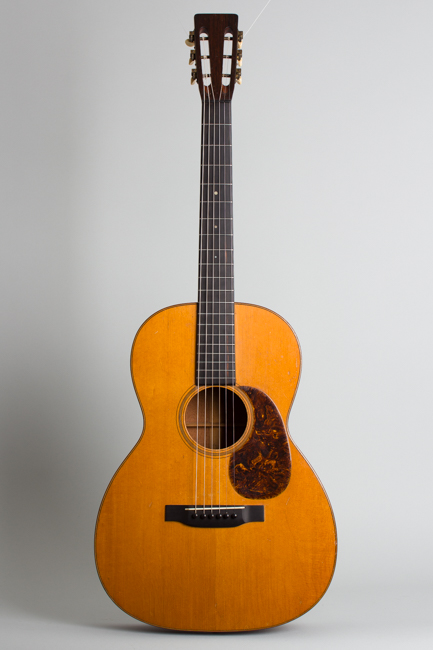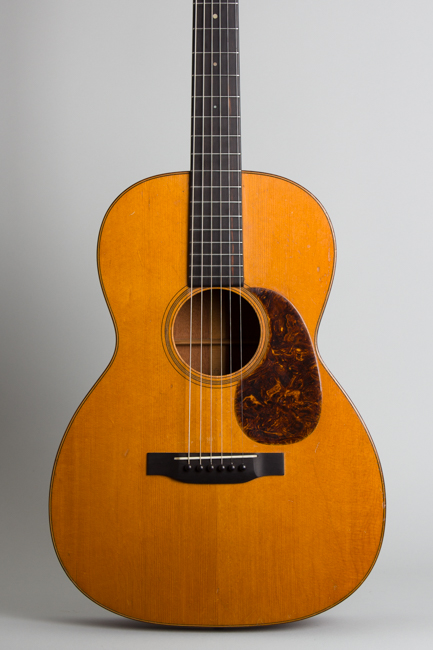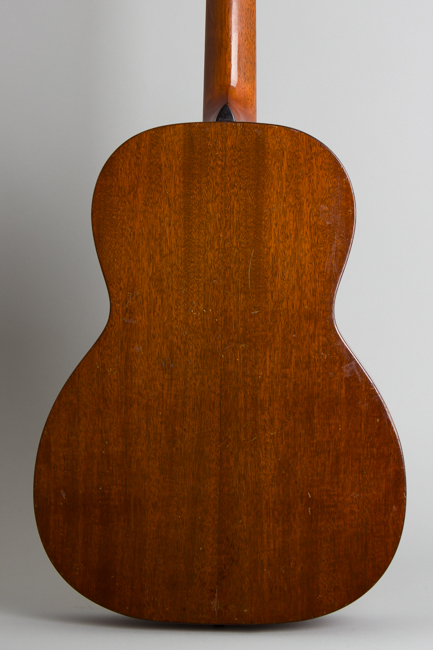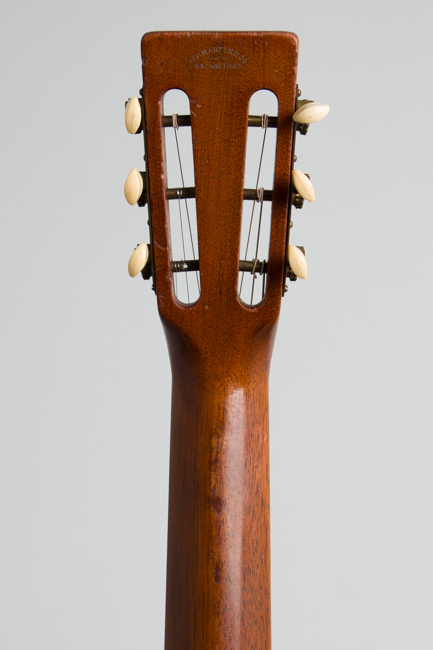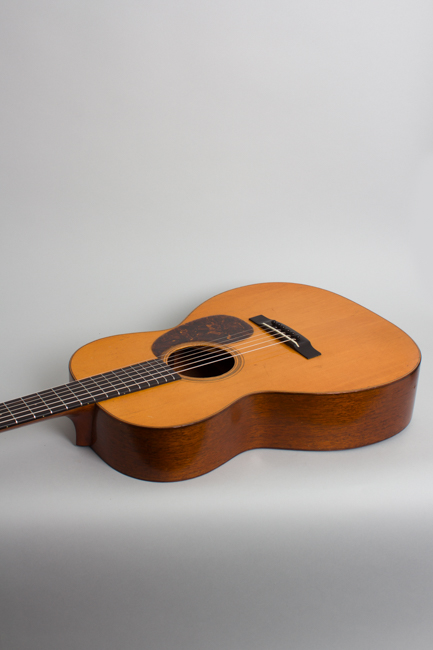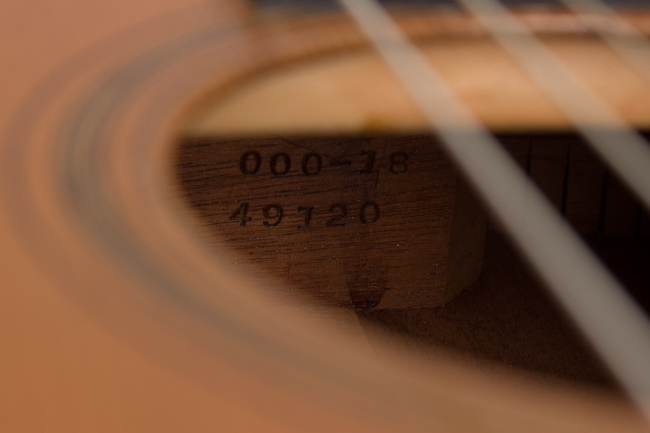C. F. Martin 000-18 Flat Top Acoustic Guitar (1931)
This item has been sold.
Item # 12441
Prices subject to change without notice.
C. F. Martin 000-18 Model Flat Top Acoustic Guitar (1931), made in Nazareth, PA, serial # 49120, natural lacquer finish, mahogany back, sides and neck; Appalachian spruce top, ebony fingerboard and bridge, black tolex hard shell case.
When this guitar was built in late 1931 the "standard model" 12-fret 000-18 had long been Martin's largest and most expensive mahogany-bodied instrument, but was suddenly an endangered species. The company's success with the new 14-fret "Orchestra Model" format led to this original pattern 000 being quickly eclipsed and discontinued. This guitar's serial number indicates it was built towards the end of 1931, making it one of the very last ones made.
By 1931 the 12-fret 000-18 was solidly a steel-string guitar, with the then-recently introduced belly bridge and pickguard as standard features. The 000-18 had only been cataloged with steel strings since the mid/late 1920s, and these added features completed its transition from a 19th century gut-string guitar. The first carved top Martin guitars appeared in 1931 as well, and even this recently modernized 12-fret 000 suddenly seemed like an obsolete model.
The October 1930 Martin catalog (and subsequent March '31 price list) showed the retail price of this 000-18 at $50 (plus case). The new OM-18 was priced at $60, but by March 1932 that was reduced to $50 as well, sounding the death knell of the old 12-fret design. The models were effectively merged, and the new 14-fret "modern" guitars were simply called 000-18s.
That's really a shame to us anyway as we find the 15" wide "standard" 000-18 to be a beautiful and big-sounding guitar, a very different animal from the admittedly sleeker OM. It is quite powerful sounding for its day but retains plenty of definition even when played hard. This had helped make it a popular choice for period vaudeville and early "hillbilly" entertainers, since it offered a lot of bang for the $50 price tag. Still 1931 was the last year for the steel-string 12-fret 000-18s before the OM design took over and all of 178 were shipped. By modern standards that is a minimal quantity. This "perfected" steel-string 000-18 with the belly bridge and pickguard only existed for this brief time; the exact numbers are not recorded but likely well under 300 of this exact version were ever built.
This particular 12-fret 000-18 has survived showing wear and repair but remaining a solid playing instrument. The Adirondack spruce top is bordered with wooden binding -- there was no plastic trim on Style 18s yet -- and wood sound hole rings. The back and sides are nicely grained mahogany. The unbound ebony fingerboard has three plain graduated-size dot inlays and bar frets. The bridge and nut are ebony and the Waverly tuners are unplated brass.
With the very light, early steel-string scalloped bracing on the 15" wide featherweight 12-fret body, this guitar just sings. The neck has a fairly slim soft "V" contour and wide ebony fingerboard and is eminently playable. This is a very versatile guitar, responding extremely well to gentle fingerpicking and to more vigorous flatpicking. This would be one of the ultimate instruments for a truly authentic 1920-30s style fiddle band, but really excels in any playing style vintage or modern. This is simply a great guitar, a rare find in a 12-fret large-body, steel-string Martin now well past its 90th birthday.
Overall length is 39 5/8 in. (100.6 cm.), 15 in. (38.1 cm.) wide at lower bout, and 4 in. (10.2 cm.) in depth at side, taken at the end block. Scale length is 25 1/4 in. (641 mm.). Width of nut is 1 7/8 in. (48 mm.).
This is a decently well-preserved guitar for its age, extremely playable with some general wear and a mix of mostly older repairs. The very thin original lacquer finish has not been oversprayed except around the heel; it shows dings, dents, and scrapes overall but very little of the pickwear so often found on the tops of old Martins. The original tortoise celluloid pickguard is in excellent shape. The back of the neck has some smooth playing wear to the wood in the lower positions and along the spine, but remains thankfully free of the deeper old capo marks often encountered.
The top and back are remarkably crack free, the top is actually in unusually good structural condition for a 000 from this period with less bellying than many. The upper side has a small grain split at the turn of the lower bass bout, while the treble side has more extensive repair. There is a long split running from the waist nearly to the endpin, with a sealed bash mark above it at the turn of the lower bout and a number of shorter grain cracks to the waist area. The repairs look ancient and are fully solid but not as neatly done as they might have been, some areas are not lined up exactly. With only a few small cleats added inside this area of cosmetically imperfect repair could be re-done if desired, but it presents no functional issues.
The neck has been reset; there is an old crack running fully through the heel that may have happened during this process. It is neatly and solidly sealed with a light ancient overfinish to this area only. The bridge is a lovely T.J. Thompson replica of the original ebony belly bridge; there is very minimal scarring around the base. The thin maple bridge plate is a correct replica recently done to the original specs; there was never an oversize plate installed. The original bridge plates on these first-generation steel strung 000's were very small and thin for the top area and often failed many decades ago. The original bar frets are intact, lowered a bit and recrowned with little subsequent wear.
While certainly not a pristine guitar, considering its 90+ years on the planet this 000 survives in excellent playing condition. This largest-bodied early '30s 12 fret mahogany Martin remains a truly fine-playing instrument, quite powerful-sounding and extremely articulate even when pushed. We rarely find early steel-string Martins of this period without extensive wear and/or damage; considering its age and rarity this 000 is an outstanding piece that we donít see often enough. Overall Very Good + Condition.
When this guitar was built in late 1931 the "standard model" 12-fret 000-18 had long been Martin's largest and most expensive mahogany-bodied instrument, but was suddenly an endangered species. The company's success with the new 14-fret "Orchestra Model" format led to this original pattern 000 being quickly eclipsed and discontinued. This guitar's serial number indicates it was built towards the end of 1931, making it one of the very last ones made.
By 1931 the 12-fret 000-18 was solidly a steel-string guitar, with the then-recently introduced belly bridge and pickguard as standard features. The 000-18 had only been cataloged with steel strings since the mid/late 1920s, and these added features completed its transition from a 19th century gut-string guitar. The first carved top Martin guitars appeared in 1931 as well, and even this recently modernized 12-fret 000 suddenly seemed like an obsolete model.
The October 1930 Martin catalog (and subsequent March '31 price list) showed the retail price of this 000-18 at $50 (plus case). The new OM-18 was priced at $60, but by March 1932 that was reduced to $50 as well, sounding the death knell of the old 12-fret design. The models were effectively merged, and the new 14-fret "modern" guitars were simply called 000-18s.
That's really a shame to us anyway as we find the 15" wide "standard" 000-18 to be a beautiful and big-sounding guitar, a very different animal from the admittedly sleeker OM. It is quite powerful sounding for its day but retains plenty of definition even when played hard. This had helped make it a popular choice for period vaudeville and early "hillbilly" entertainers, since it offered a lot of bang for the $50 price tag. Still 1931 was the last year for the steel-string 12-fret 000-18s before the OM design took over and all of 178 were shipped. By modern standards that is a minimal quantity. This "perfected" steel-string 000-18 with the belly bridge and pickguard only existed for this brief time; the exact numbers are not recorded but likely well under 300 of this exact version were ever built.
This particular 12-fret 000-18 has survived showing wear and repair but remaining a solid playing instrument. The Adirondack spruce top is bordered with wooden binding -- there was no plastic trim on Style 18s yet -- and wood sound hole rings. The back and sides are nicely grained mahogany. The unbound ebony fingerboard has three plain graduated-size dot inlays and bar frets. The bridge and nut are ebony and the Waverly tuners are unplated brass.
With the very light, early steel-string scalloped bracing on the 15" wide featherweight 12-fret body, this guitar just sings. The neck has a fairly slim soft "V" contour and wide ebony fingerboard and is eminently playable. This is a very versatile guitar, responding extremely well to gentle fingerpicking and to more vigorous flatpicking. This would be one of the ultimate instruments for a truly authentic 1920-30s style fiddle band, but really excels in any playing style vintage or modern. This is simply a great guitar, a rare find in a 12-fret large-body, steel-string Martin now well past its 90th birthday.
Overall length is 39 5/8 in. (100.6 cm.), 15 in. (38.1 cm.) wide at lower bout, and 4 in. (10.2 cm.) in depth at side, taken at the end block. Scale length is 25 1/4 in. (641 mm.). Width of nut is 1 7/8 in. (48 mm.).
This is a decently well-preserved guitar for its age, extremely playable with some general wear and a mix of mostly older repairs. The very thin original lacquer finish has not been oversprayed except around the heel; it shows dings, dents, and scrapes overall but very little of the pickwear so often found on the tops of old Martins. The original tortoise celluloid pickguard is in excellent shape. The back of the neck has some smooth playing wear to the wood in the lower positions and along the spine, but remains thankfully free of the deeper old capo marks often encountered.
The top and back are remarkably crack free, the top is actually in unusually good structural condition for a 000 from this period with less bellying than many. The upper side has a small grain split at the turn of the lower bass bout, while the treble side has more extensive repair. There is a long split running from the waist nearly to the endpin, with a sealed bash mark above it at the turn of the lower bout and a number of shorter grain cracks to the waist area. The repairs look ancient and are fully solid but not as neatly done as they might have been, some areas are not lined up exactly. With only a few small cleats added inside this area of cosmetically imperfect repair could be re-done if desired, but it presents no functional issues.
The neck has been reset; there is an old crack running fully through the heel that may have happened during this process. It is neatly and solidly sealed with a light ancient overfinish to this area only. The bridge is a lovely T.J. Thompson replica of the original ebony belly bridge; there is very minimal scarring around the base. The thin maple bridge plate is a correct replica recently done to the original specs; there was never an oversize plate installed. The original bridge plates on these first-generation steel strung 000's were very small and thin for the top area and often failed many decades ago. The original bar frets are intact, lowered a bit and recrowned with little subsequent wear.
While certainly not a pristine guitar, considering its 90+ years on the planet this 000 survives in excellent playing condition. This largest-bodied early '30s 12 fret mahogany Martin remains a truly fine-playing instrument, quite powerful-sounding and extremely articulate even when pushed. We rarely find early steel-string Martins of this period without extensive wear and/or damage; considering its age and rarity this 000 is an outstanding piece that we donít see often enough. Overall Very Good + Condition.
